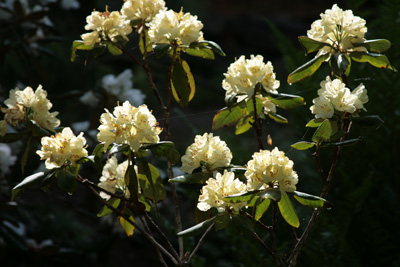
THE GARDEN
We gardeners have been waiting for spring. However, during May, PATIENCE is the rule. A common problem is planting too soon. If the soil is too cold or wet seeds may rot and roots may stop growing.
Soil temperature should be above 50 F. If soil feels cold in your hand, it’s too cold for plants! Try making a ball with a handful of soil. Does it crumble? Great. Does it form a ball? It’s too wet.
Purchase compact, healthy plants with unopened buds that are appropriate for your gardens. Read plant tags and note the final height and width. Are they appropriate for your space? Mix compost, or other organic materials into the soil before planting. Mulch lightly around the new plants.
Planting holes should be a deep as the root mass and twice as wide. Be sure to spread or “spider” the roots to encourage root growth into the soil instead of circling, self-strangling roots which can lead to disaster.
Leave bulb foliage intact until it yellows and wilts, but remove spent flowers to prevent seed formation. The foliage is required to give bulbs the food necessary to form next year’s blooms. Spring bulbs can be moved or divided as soon as the foliage dies. Do the same for bearded irises so the energy goes into the rhizomes. Divide Virginia bluebells, bloodroot, trilliums, and other spring ephemerals when the leaves turn yellow and before they disappear from sight.
Weeding never ends. Mulching helps. Plant warm-season annuals by mid-June, before it gets too hot for them to establish good roots. These include cosmos, marigolds, begonias, torenias, petunias, ageratum, and cleome.
Check for signs of insects (chewed leaves, puncture wounds, sticky substances, trails in leaves) or disease (yellow leaves, stunted growth, signs of fungi). Be sure to look on both sides of the leaves before buying any plant. Don’t forget to check for healthy roots. Slug control can start as soon as you can get into the garden. Take a look on top and under the leaves of tomato, potato, pepper, and eggplants for hornworm eggs (only one-tenth of an inch in diameter). Yellow trails in columbine leaves are caused by leaf miners, the larva of a genus of fly. This is more of an aesthetic problem … you don’t have to do anything OR you can remove the affected leaves.
Buy yourself at least one new plant! Consider some native plant species to help pollinators and to feed young birds. Keep newly planted trees, shrubs, vegetables, perennials, and flowers well-watered (about one inch per week.)
Try deer repellants or consider deer resistant plants. Check the Cornell website for a great deer resistant plant list.
Cut back spring-flowering perennials such as pulmonaria and perennial geraniums after they bloom to encourage reblooming and/or growth of new foliage. Deadhead perennials and annuals to prevent seed formation and to encourage new growth and more flowers.
At the end of June, cut back perennials such as phlox, beebalm, sedum, aster, and goldenrod by one-third to one-half to control height or delay flowering. This is known as the Chelsea Chop.
Place supports over taller flowering plants so the plants can grow up through them without damage to foliage and flowers later in the season.
Spring-blooming shrubs like weigela, forsythias, and spirea can be pruned back after blooming. Cut about one-third of the oldest stems to the ground for renovation.
If growing azaleas and/or rhododendrons in higher pH soil be sure to add acidifying agents. However, don’t disturb the roots.
THE LAWN
Mow lawn at least three inches high. This encourages deeper, healthier root growth. Leave grass clippings on the lawn to return nutrients to the soil.
The first application of lawn fertilizer, if needed, can be put down around Memorial Day. If fertilizer was applied in the fall a spring application is not necessary. A quarter to a half inch top dressing of compost adds nutrients, feeds soil microbes, and improves the water-holding capacity of the soil.
For optimal pre-emergent crabgrass control, do not apply until soil is close to 60 degrees. Crabgrass doesn’t germinate until the soil temperature 2 inches deep is between 60 & 64 degrees. Applying when the ground is too cold is a waste of money and chemicals.
VEGETABLES
Check the Cornell recommended vegetable list for suggested and disease resistant varieties. vegvariety.cce.cornell.edu
Plant your brassicas now: broccoli, cauliflower, Brussels sprouts and summer cabbage. Reseed bush beans every few weeks to increase production.
Plant your tomatoes, eggplant, squash, pumpkins, cucumbers, and peppers when the ground is warm to promote root growth. Usually this time comes closer to the end of May.
After direct-sowing seeds, be sure to thin the seedlings to prevent crowding and competition for light, water, and fertilizer. If plants were grown from seed be sure to harden them off before planting them in the garden.
—Carol Ann Harlos and Lyn Chimera, Master Gardeners, Erie County
Views: 0





